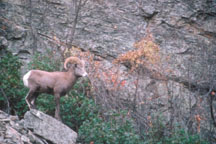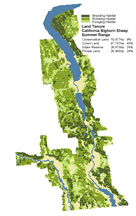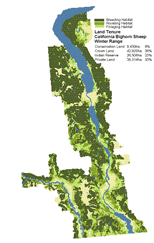|
Habitat Atlas for Wildlife at Risk
California Bighorn Sheep
Ovis canadensis californiana

California
Bighorn Sheep
|

- Weight: adult rams, 70-115 kg; adult
ewes, 50-75 kg.
- Length: rams, 1.5 metres; ewes are approximately
15 percent smaller.
- Coat greyish-brown to dark brown.
- A short dark tail is outlined by a large white
rump patch; a band of white trim outlines the backs
of all
four legs.
- Adult males have massive curling horns which develop
to form a full circle.
- Female horns are thinner and rarely exceed 25
cm.
- Maximum lifespan is 12-14 years.
Status:
British Columbia Blue List
Special Significance
California Bighorn Sheep no longer occur in many areas
of the Okanagan because of degradation of habitat,
changes in predation mortality and historical over-harvest
by legal or illegal hunting. The invasion of non-native
plants, intensive cattle grazing, fire suppression,
timber harvesting, and land development are factors
that have limited access to forage plants. Sheep
survival depends on familiarity with their habitat
and they are slow to re-occupy vacant habitats.
Distribution
- In British Columbia, bighorns occur in scattered herds in the
Ashnola River system, the east side of the South Okanagan Valley,
Shorts Creek
west of Okanagan Lake, the Fraser River basin from
Lillooet north to Williams Lake, the upper Taseko and Chilko Rivers,
and an isolated
herd on Far Mountain, north of Anaheim Lake; two
transplanted herds have been established, near Kamloops Lake and
Grand Forks.
- In the South Okanagan elevational range during winter
is often below 600 m but can range up to 1800 m;
summer range elevation can range from lake level to 1550 metres.
Habitat

- Winter range is the limiting habitat for bighorns; two types of
winter range in close proximity are required: normal winter range
with access
to food and escape terrain, and severe winter range
with large canopied trees for relief from deep snow.
- Escape terrain is critical for avoiding predators and
is provided by cliffs and rocky slopes, and dense
timber patches bordering winter foraging sites.
- Normal winter range includes low elevation, bunchgrass
ranges on south and west facing slopes, mature
open ponderosa pine or Douglas-fir forest, rocky bluffs, and dry,
open rocky areas with
scattered scrub timber; sheep avoid closed forests
and areas with a snow cover of greater than 15 percent.
- Many herds do not have available alpine habitat typical
of summer range, and remain in one general location
year-round; some herds in the Ashnola spend summer in subalpine
forest, or open forest
below the subalpine.
- Rutting grounds generally occur on ewe winter ranges.
- Breeding takes place on high, grassy slopes of the
winter range, and lambing generally occurs on escape
terrain (steep rock bluffs or expansive areas of steep, rugged terrain)
adjoining
the winter range grasslands (characterized by rich
soils with abundant spring grassland forage).
- Bighorns are predominantly grazers, relying on grassland
habitats; ewes without lambs and rams are generally
found foraging in open grass slopes and agricultural areas; ewes
with lambs are more
likely to forage in bluff tops and talus slopes
during late spring, and grass slopes with rock outcrops from late
spring to autumn; in
late summer, they may also be found in open canopy
forests adjacent to rock bluffs; spring forage sites are generally
found on south or
southwest aspects.
- Open forested habitat is usually used during transition,
however less suitable habitats may also be used;
sheep migrate quickly through densely forested habitat, avoiding
areas of human disturbance,
including major roads, which are often crossed
at night.
Reproduction
- Breeding occurs in the Ashnola from late November to early December;
on the east side of the South Okanagan Valley,
the rut occurs from mid-October to late December.
- Gestation period is approximately 6 months; ewes give
birth to usually one lamb (occasionally twins)
from April to late June.
Food Habits
- Grasses, sedges and soft-stemmed plants comprise the majority of
the diet, but up to 25 percent of diet may be comprised of shrubs
such as sage, saskatoon, mock orange, bearberry, juniper and willow.
Interesting Facts
- Rams over three years old usually segregate into separate bands from
ewes, young and sub-adults. Rams assess their body weight and condition,
relative to other rams, by head butting. The ram that rebounds most
in these violent clashes is the lighter of the two. Ram groups establish
and maintain a social hierarchy through head butting and other displays.
Threats
- Fire suppression causes forest encroachment on
grasslands.
- Habitat loss and fragmentation due to urban development
in low elevation shrub-grasslands.
- Inappropriate grazing by livestock in remaining
shrub-grassland areas.
- Areas of human disturbance, including major
roads.
- Increased human access into critical areas
such as lambing grounds, primarily due
to logging roads.
- Invasive weeds which outcompete native grasses
and forbs.
- Domestic dogs.
- Recreational activities in rocky habitats (e.g.
rock climbing; mountain biking; hiking),
particularly during lambing season (April - late May).
- Seeding rangeland with non-native grasses.
- Inappropriate disposal of livestock carcasses
which unnaturally increases coyote population.
- Low-level helicopter flights during early
lambing period.
- Poorly located sanitary landfills and lack
of scavenger fencing unnaturally increases
scavengers that prey on sheep and
lambs.
- Transfer of disease from domestic sheep and
llamas may be fatal.
Management Considerations
- Protect known lambing sites from human disturbance;
limit access into critical lambing areas.
Access management plans should be developed for areas
of concern.
- Protect and maintain large tracts of low elevation
shrub-grassland.
- Employ land management practices which encourage
the growth of healthy indigenous grassland
communities.
- Control weeds and seed rangelands with native
grasses.
- Set boundaries for intensively used recreational
areas; promote an increased understanding
among recreational vehicle users and rock-climbers
of the habitat requirements of sheep.
- Properly dispose of livestock carcasses; use
fencing and develop a cover material program
at landfills to discourage cougar and coyote
predators.
- Discourage introduction of domestic sheep and
llamas close to bighorn habitat sites.
- Design Range Use Plans and Forest Development
Plans to protect habitat requirements of
sheep.
- Fence highways where appropriate; design must
incorporate solutions for potential predator
traps and loss of access to water.
- Consider seasonal migration corridors and implement
a strategy to ensure corridors are not disrupted
by development; increase awareness through
signage or subdivision covenants to limit free-roaming
domestic dogs where development has already
occurred.
- Encourage development of fire management plans
to enhance rangeland.
|
References
1. Banfield, A.W.F. 1977. The mammals of Canada. Published by the
University of Toronto Press.
2. Takoff, M.E. 1988. Draft. Lamb production, lamb
mortality and habitat use of the Vaseux band of California bighorn
sheep. Ministry of Water, Land and Air Protection Lands and Parks,
Penticton, British Columbia.
|